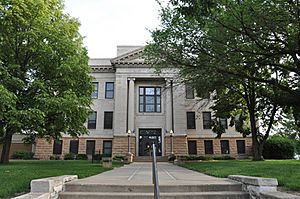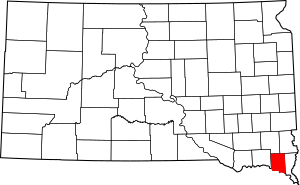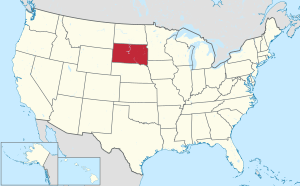Clay County, South Dakota facts for kids
Quick facts for kids
Clay County
|
|
|---|---|

Clay County Courthouse
|
|

Location within the U.S. state of South Dakota
|
|
 South Dakota's location within the U.S. |
|
| Country | |
| State | |
| Founded | 1862 |
| Named for | Henry Clay |
| Seat | Vermillion |
| Largest city | Vermillion |
| Area | |
| • Total | 417 sq mi (1,080 km2) |
| • Land | 412 sq mi (1,070 km2) |
| • Water | 5.1 sq mi (13 km2) 1.2% |
| Population
(2020)
|
|
| • Total | 14,967 |
| • Estimate
(2023)
|
15,431 |
| • Density | 35.89/sq mi (13.858/km2) |
| Time zone | UTC−6 (Central) |
| • Summer (DST) | UTC−5 (CDT) |
| Congressional district | At-large |
Clay County is a county in the U.S. state of South Dakota. As of the 2020 census, the population was 14,967. The county seat is Vermillion, which is also home to the University of South Dakota. The county is named for Henry Clay, American statesman, US Senator from Kentucky, and United States Secretary of State in the 19th century. Clay County comprises the Vermillion, SD Micropolitan Statistical Area, which is also included in the Sioux City-Vermillion, Iowa-SD-Nebraska Combined Statistical Area.
Contents
History
The future Clay County area was opened for legal settlement in 1859. In Autumn 1859, Ahira A. Partridge (who would become the first elected sheriff of the county) crossed the Missouri river into the Dakota territory, and became the first white man to settle, on 160 acres of land that now underlies Vermillion. In 1862 the county was formally organized. The Clay County Courthouse was built in 1912.
Clay County is the name of 17 other counties in the United States, most of them named for Henry Clay.
Geography
Clay County lies on the south line of South Dakota. The south boundary line of Clay County abuts the north line of the state of Nebraska (across the Missouri River). The Missouri River flows southeast along the south boundary line of Clay County. A small drainage creek flows into the county from Turner County, draining the central and eastern portions of the county and discharging into the river. Smaller drainages move water from the western county areas into the river. In addition to sloping into the drainage through the center of the county, the terrain generally slopes to the south. The area is largely devoted to agriculture.
The county has a total area of 417 square miles (1,080 km2), of which 412 square miles (1,070 km2) is land and 5.1 square miles (13 km2) (1.2%) is water. It is the smallest county by area in South Dakota.
Adjacent counties
- Turner County - north
- Lincoln County - northeast
- Union County - east
- Dixon County, Nebraska - southeast
- Cedar County, Nebraska - southwest
- Yankton County - west
Major highways
Protected areas
- Missouri National Recreational River (part)
- Spirit Mound State Historic Prairie
Demographics
| Historical population | |||
|---|---|---|---|
| Census | Pop. | %± | |
| 1870 | 2,621 | — | |
| 1880 | 5,001 | 90.8% | |
| 1890 | 7,509 | 50.1% | |
| 1900 | 9,316 | 24.1% | |
| 1910 | 8,711 | −6.5% | |
| 1920 | 9,654 | 10.8% | |
| 1930 | 10,088 | 4.5% | |
| 1940 | 9,592 | −4.9% | |
| 1950 | 10,993 | 14.6% | |
| 1960 | 10,810 | −1.7% | |
| 1970 | 12,923 | 19.5% | |
| 1980 | 13,689 | 5.9% | |
| 1990 | 13,186 | −3.7% | |
| 2000 | 13,537 | 2.7% | |
| 2010 | 13,864 | 2.4% | |
| 2020 | 14,967 | 8.0% | |
| 2023 (est.) | 15,431 | 11.3% | |
| U.S. Decennial Census 1790-1960 1900-1990 1990-2000 2010-2020 |
|||
2020 census
As of the 2020 census, there were 14,967 people, 5,564 households, and 2,795 families residing in the county. The population density was 36.3 inhabitants per square mile (14.0/km2). There were 6,180 housing units.
2010 census
As of the 2010 census, there were 13,864 people, 5,110 households, and 2,628 families in the county. The population density was 33.6 inhabitants per square mile (13.0/km2). There were 5,639 housing units at an average density of 13.7 per square mile (5.3/km2). The racial makeup of the county was 91.1% White, 3.1% American Indian, 1.7% Asian, 1.3% black or African American, 0.5% from other races, and 2.3% from two or more races. Those of Hispanic or Latino origin made up 2.0% of the population. In terms of ancestry, 43.9% were German, 16.4% were Norwegian, 15.8% were Irish, 8.7% were English, 5.4% were Swedish, and 1.8% were American.
Of the 5,110 households, 24.7% had children under the age of 18 living with them, 40.9% were married couples living together, 7.3% had a female householder with no husband present, 48.6% were non-families, and 32.4% of all households were made up of individuals. The average household size was 2.28 and the average family size was 2.91. The median age was 25.0 years.
The median income for a household in the county was $37,198 and the median income for a family was $61,159. Males had a median income of $37,059 versus $28,016 for females. The per capita income for the county was $19,518. About 8.0% of families and 24.0% of the population were below the poverty line, including 13.6% of those under age 18 and 6.7% of those age 65 or over.
Racial/ethnic makeup
The racial makeup of the county was 92.78% White, 1.00% Black or African American, 2.66% Native American, 1.95% Asian, 0.01% Pacific Islander, 0.29% from other races, and 1.31% from two or more races. 0.89% of the population were Hispanic or Latino of any race. 32.0% were of German, 15.6% Norwegian, 9.9% Irish and 5.4% English ancestry.
Religion
From 2000 Census data, over 50% consider themselves "unclaimed".
- Mainline Protestant with 3,840 is most common around 28%; mainly Lutheran;
- Catholic with 1820 comes second around 13%;
- Evangelical Protestant with 613 would be around 5%; mainly Lutheran Church–Missouri Synod and Southern Baptist.
Education
- University of South Dakota - In 1862 the territorial legislature located the State University in Vermillion, but nothing was done until 1882 when Clay County voted $10,000 in bonds to construct a building on its campus.
Communities
Cities
- Irene (partial)
- Vermillion (county seat)
Town
Census-designated places
Unincorporated communities
- Alsen (partial)
- Dalesburg
- Greenfield
- Hub City
- Westreville
Townships
- Bethel
- Fairview
- Garfield
- Glenwood
- Meckling
- Norway
- Pleasant Valley
- Prairie Center
- Riverside
- Spirit Mound
- Star
- Vermillion
See also
 In Spanish: Condado de Clay (Dakota del Sur) para niños
In Spanish: Condado de Clay (Dakota del Sur) para niños

